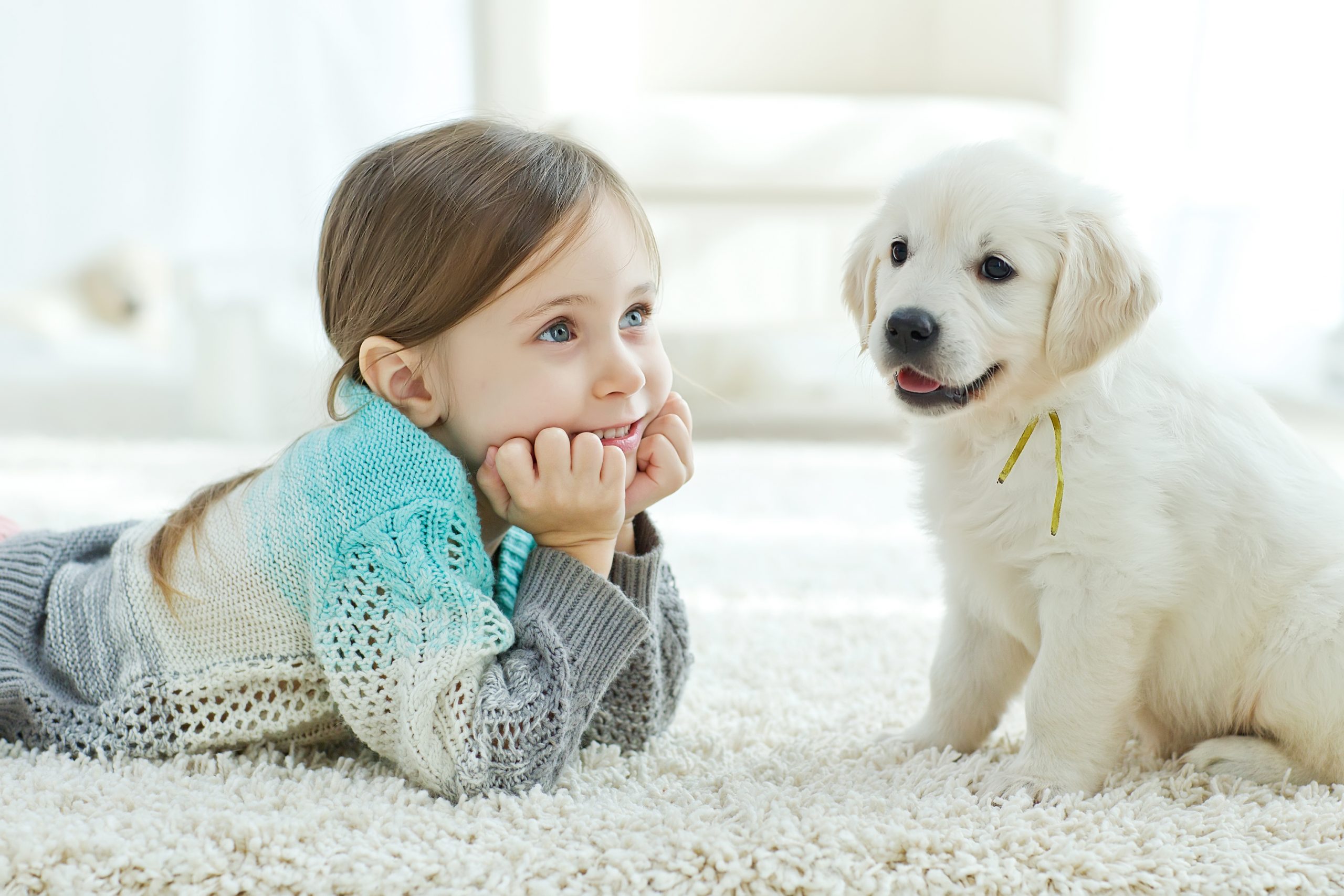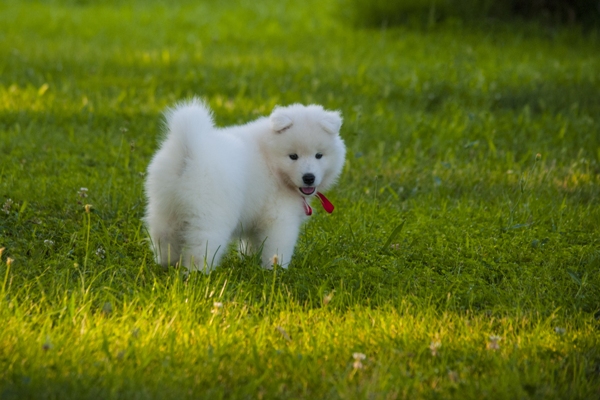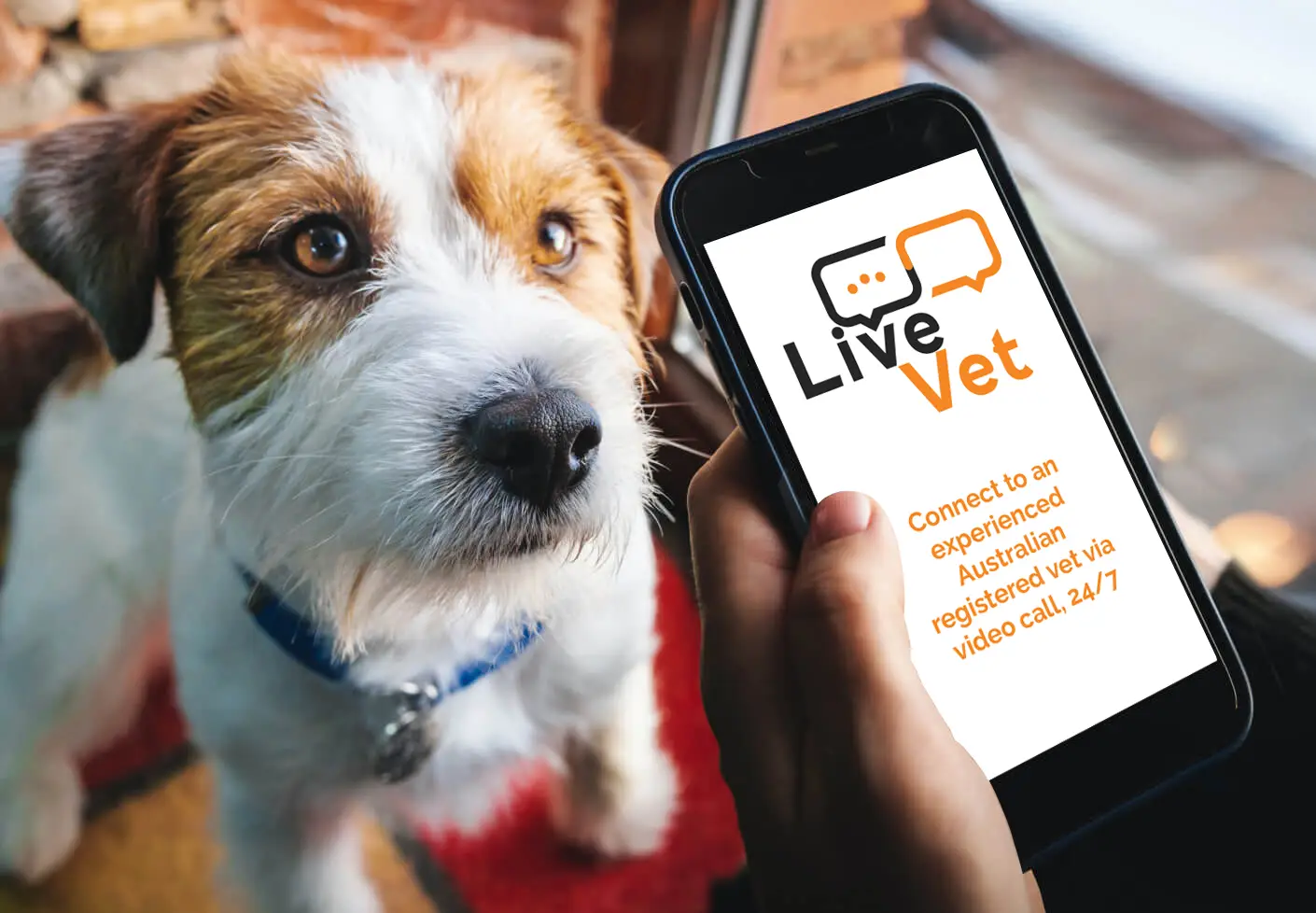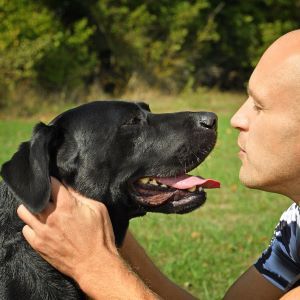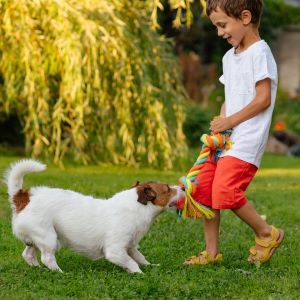Understanding dog body language signals, expressions & behaviour

For any dog owner in the process of building a positive relationship with their dog, understanding dog body language is key. To communicate more effectively with our dogs, we need to learn and understand dog body language.
Knowledge of dog body language, and the ability to accurately identify it, will greatly help us decipher what our dog is trying to communicate. Take tail wagging, for example. Most of us think it’s a sign of a friendly, happy dog. And in many cases, we would be correct. But there are tail wags that could mean something else entirely! (To discover what other meanings there are to a wagging tail, read on!)
It goes without saying that body language in dogs is quite different from our own. Dogs cannot speak like we humans do, and when they do try and ‘talk’ to us verbally through barking, yipping, yelping, whining or crying, most of the time we tell them to be quiet!
While we humans are very strong verbal communicators, dogs communicate strongly via their unique dog body language. We also need to understand that dogs may struggle to interpret our non-verbal communication because we have only two legs, small, rigid ears and no tail with which to signal our intentions!
Dog body language chart
 It can be valuable to print out a dog body language chart such as the one below and place it somewhere easily visible in your home. Understanding dog behaviour and learning to interpret dog body language will take time, patience and perseverance, but it is definitely worthwhile in the long run.
It can be valuable to print out a dog body language chart such as the one below and place it somewhere easily visible in your home. Understanding dog behaviour and learning to interpret dog body language will take time, patience and perseverance, but it is definitely worthwhile in the long run.
Understanding body language in dogs and being able to interpret their communication signs can greatly enhance your relationship with your furry friend as well as reduce the likelihood of behavioural problems and other issues from developing down the line.
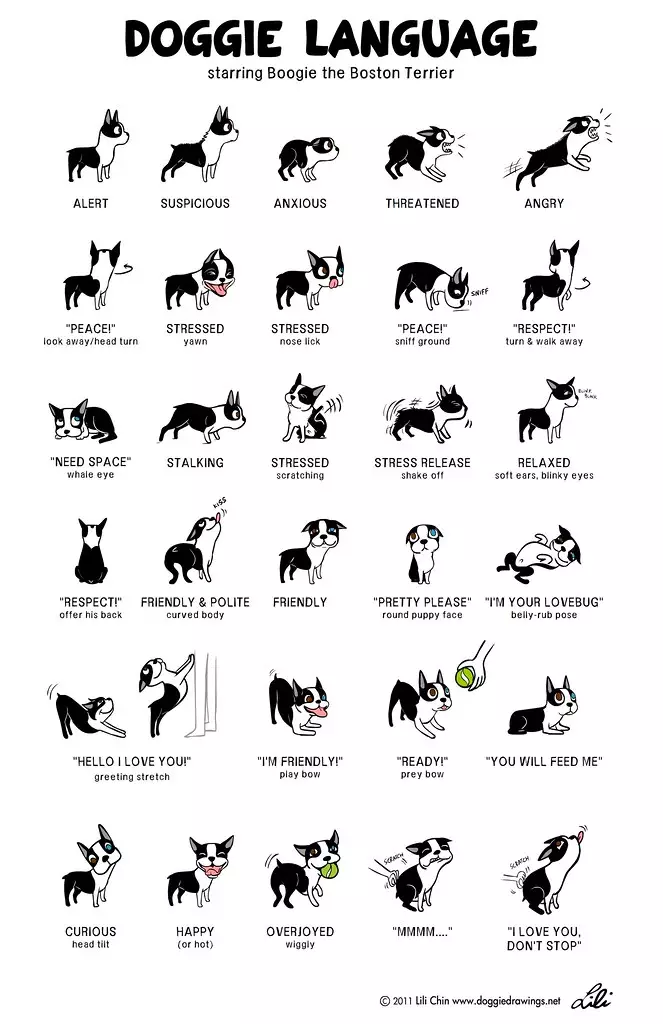
Source: https://www.flickr.com/photos/lilita/5652847156/sizes/l/
Interpreting dog language
Dogs primarily communicate non-verbally through a species-specific dog body language, with communication signals we humans can easily miss if we are not observant. So, apart from listening to what our dogs are trying to tell us, even more importantly, we need to watch and see what messages they are trying to convey.
When dogs vocalise with barks, growls, yips and yelps, they may be sending out a number of different messages that could be happy, demanding, angry or questioning. Try to recognise the difference between the ‘yip’ when you get the lead out, the excited bark when the doorbell rings, and the nervous bark when your dog hears something unusual.
In addition to their vocalisations, understanding dog behaviours and dog body language is key to interpreting what your dog is trying to tell you. These non-verbal signs and signals can be much more difficult for us to interpret than their verbal expressions. To help you gain some basic understanding, we have put together some examples of common dog body language signals and explain what they mean.
Calming and stress signals
Calming signals are given out by a dog to help calm down a situation. Dogs have a highly developed set of calming signals that they use to reduce the chances of aggression and conflict with other dogs, their human companions and other species they may be living with. These more pacifying signals are in contrast with some of the more aggressive dog body language exhibited (see Aggressive Signals below).
Calming signals are often called stress signals, and whilst many of these signals are the same, their interpretation depends on the actual context or situation in which they occur. There is also overlap with the terms ‘conflict signals’ and ‘displacement signals’.
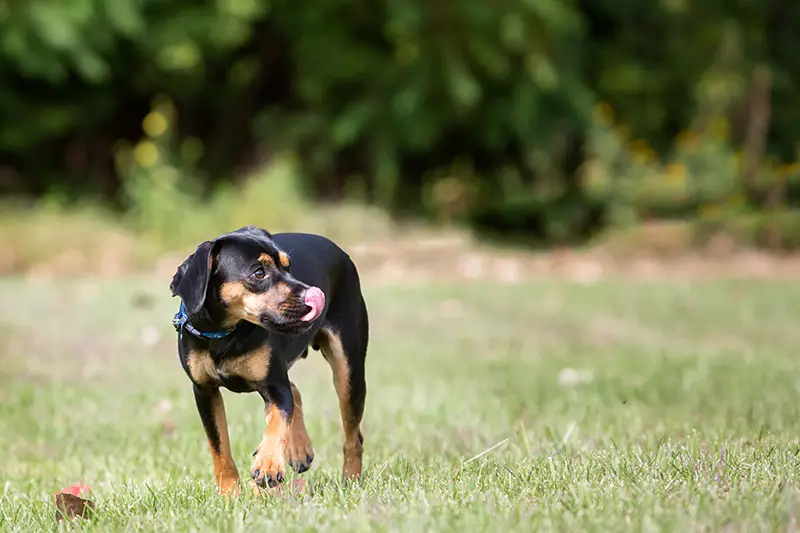
For example: You are with your puppy in a café. A stranger comes up to you and their hand reaches out to pat the puppy. The puppy yawns and turns his head away. This is a clear signal of stress as your puppy is not happy about the stranger approaching and reaching out. The stranger continues to reach out, and your puppy licks the stranger’s hand. Now your puppy uses appeasement behaviour to signal that he is not going to cause harm and also to indicate that he wants the stranger to not cause any harm. Despite these calming signals, your puppy may not be happy about this interaction.
Another example: You are standing at a bus stop and ask your dog to sit as a bus approaches. Your dog puts its nose on the ground and sniffs even though there is nothing interesting. Your dog may be feeling somewhat overwhelmed with the bus approaching, and cannot sit as he doesn’t feel it is safe to do so. Instead he decides to sniff the ground. It is almost like when a person is involved in a tricky conversation and rather than participating, opens up their phone to check Facebook.
If a dog misses out on appropriate early socialisation opportunities as puppy, he may be unable to send calming signals or interpret those sent out by another dog. He may also struggle to meet and greet other dogs effectively.
Calming signals include:
- Circling
- Lip licking
- Yawning
- Sniffing the ground
- Looking away
- Moving slowly and deliberately
- Distracted sniffing
- Sitting or lying down
Examples of calming signals:
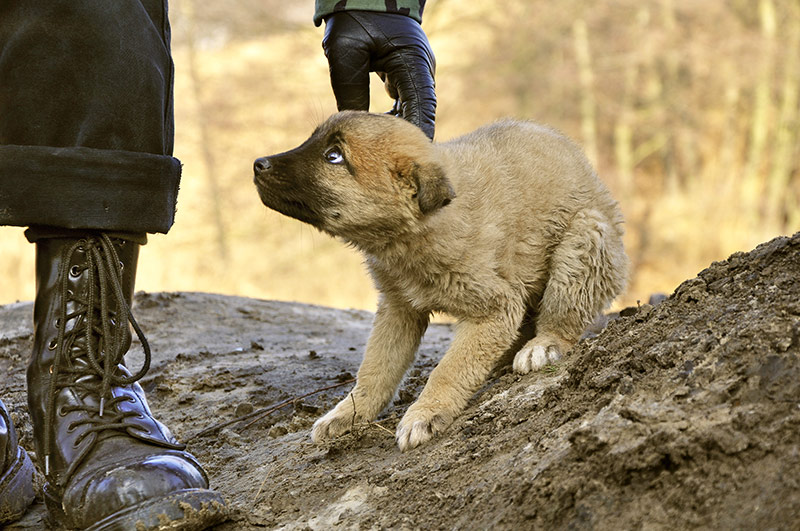 |
“I am scared”
|
 |
“I am not sure”
Someone is approaching this puppy who it is not sure about. This puppy is not sure about the situation and what to do. Signals of conflict are:
|
 |
“I am alert”
“There is something”, this puppy is thinking. The puppy is neither unsure nor confident, but alert about what is ahead.
|
|
|
“I am no harm”
The puppy opens itself to another dog.
|
Read our Puppy Guide
Bringing home and looking after a new puppy can be a big challenge!
Our Puppy Guide is an easy to use comprehensive guide for new pet parents, jammed pack full of useful information, that has been developed by pet professionals and puppy trainers.
Stress and discomfort signals
Look out for these dog common stress signals:
- Yawning but not being tired
- Lip licking
- Turning away and avoidance
- Ears tucked in
- Whale eyes (when your dog shows the whites of his eyes)
- Panting
- Scratching
Examples of stress and discomfort signals:
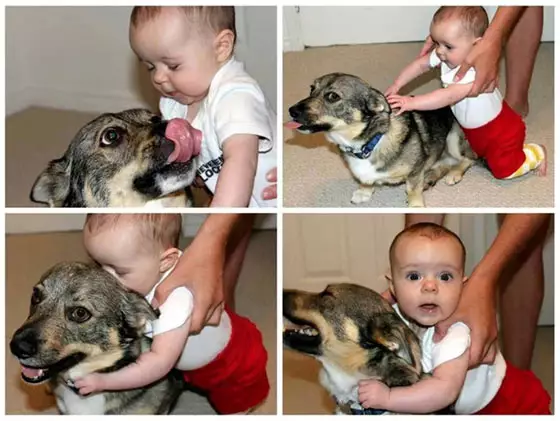
These photos illustrate a dog showing clear signs of stress and discomfort. In all four photos you can see from its body language that the dog is not happy.
This video of a toddler jumping on a dog is another good example of a dog demonstrating through body language how unhappy he is. The number of stress signals this dog shows is almost endless. This dog is clearly pushed way too far.
The following video shows that those stress signals can be way more subtle and hence easily missed:
Aggressive signals
Aggressive dog body language can be easier to read than some of the more subtle signals, such as the calming signals. These dog expressions are warning the other dog or person to stop what they or doing or they will defend themselves, their territory or possessions from the perceived threat. Dog body language signs of aggression may include both verbal and non-verbal signals.
If the other dog or person receiving these signals is able to interpret them correctly, he or she can respond with calming signals and diffuse the situation. It is when the receiver cannot read the dog body language being displayed as signs of aggression, and responds inappropriately, that physical violence can ensue.
Aggressive dog language – Verbal:
- Growling
- Barking
- Air snapping
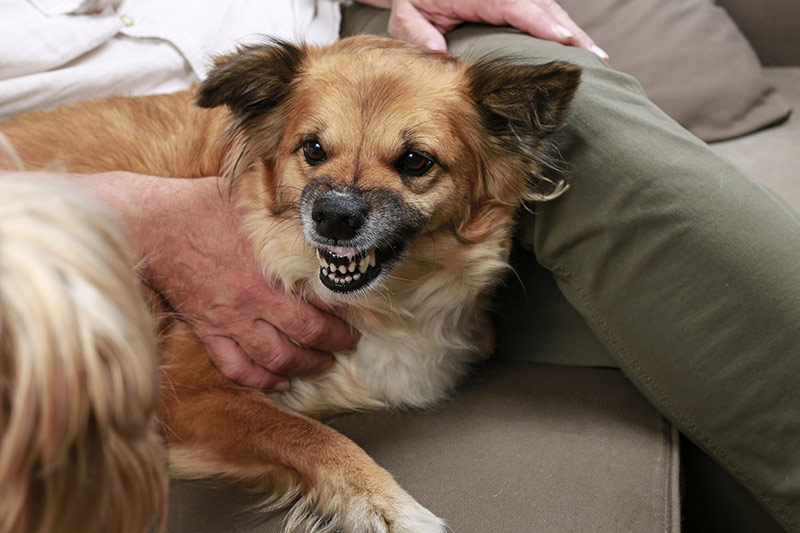
Aggressive dog body language – Non-verbal:
- Showing teeth
- Ears pinned back, flat against the head or pointed forward
- Raised hackles
- Hard stare
- Low head stance
- Stiffening or freezing of the body
- Lips skinned back, curled lips
- Tail upright and quivering or straight out and not wagging
- Whale eye – widened eyes with a lot of white showing
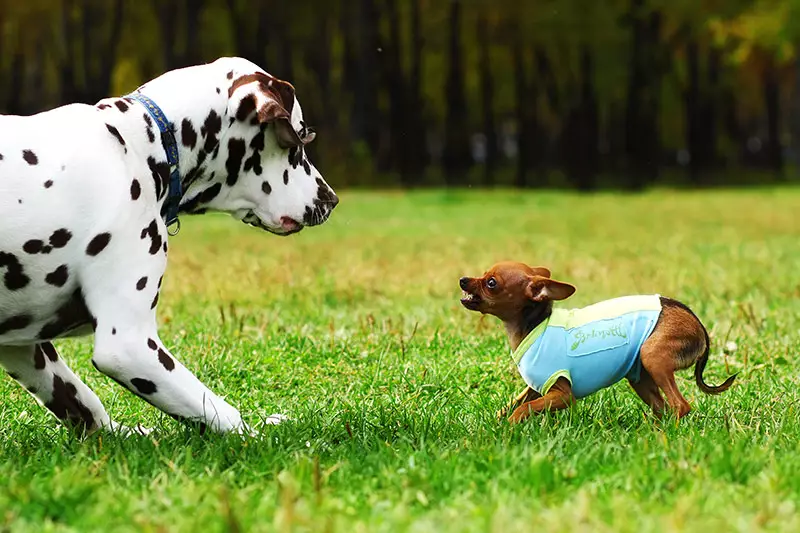
Why dogs bite and how we can help to prevent dog bites
It is important to know that dogs can bite regardless of how much they love us! In the vast majority of incidents where kids get bitten by dogs, the dog is familiar to them. This may sound surprising, but it actually isn’t. We have a tendency to trust our dogs to always do the right thing and forget they are animals at the end of the day.
A large part of the problem is that we often miss or misread dog communication signs. It is even more important in households with young children not to miss the signals your dog is giving. For example, if a dog licks his lips, we think he is hungry, but we may be missing a subtle dog communication sign of discomfort.
We often also ignore the not-so-subtle warnings a dog gives us before it bites by means of aggressive dog body language signals. A snap or a bite is the dog’s way of saying “I have told you many times that I am not happy with what you are doing, so now finally back off”, but that might already be too late for the child.
Your dog does not want to bite, but it may be his last resort after he has shown you through his body language that he is not happy with a particular situation. Unfortunately, as a result of the way kids interact with dogs, the majority of bites end up being to their faces.
Relaxed, happy and playful signals
Dogs communicate very differently to humans. If a dog is happy his mouth will be slightly open and his body posture soft. When dogs play, we sometimes think that open mouths and showing teeth is aggression, but in most cases, it is totally normal play behaviour.
We have put together a few examples of happy and playful dog body language and what it is telling you. The signals below are called play signals and are given out to invite play or during play.
Examples of relaxed, happy and playful signals:
 |
“I am ready”
This puppy is happy and relaxed. Its body language is all soft and so are its eyes and ears. Its mouth is slightly open, but there is no panting. The puppy is attentive and is looking forward to what is next. |

|
“I want to play”
The puppy is play bowing with its butt in the air and elbows on the ground, or issuing a friendly invite with a lifted paw. These are both clear signals that the dog wants to play. |
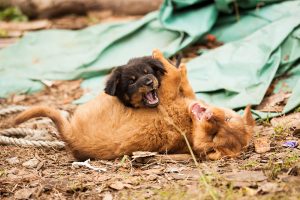 |
“Grrr… but it’s all play”
|
 |
“I am happy”
There is not much doubt about what this puppy’s face says – pure happiness! |
Why do some dogs not seem to understand dog body language?
Puppies start to learn the intricacies of dog body language from day one of life. They learn from their mum, their litter mates and any other dogs they are raised with until they get adopted by their new family, which generally occurs around the age of 8 to 10 weeks. Thereafter, learning continues through controlled play with other dogs and attending puppy classes at an early age, ideally between 8 and 16 weeks. At puppy school they learn to communicate and socialise with puppies who are not their litter mates and who do not look, and may not behave, like their litter mates; a very important and necessary skill.
 Puppies need lots of opportunity to practice reading dog expressions and interpreting dog communication signs. To behave appropriately around other dogs, as puppies they need to learn both how to signal their intentions and to understand the signals they receive. Dogs may struggle to understand another dog’s body language if they have missed out on any of these opportunities, for example, they are separated too early from their mum and litter mates or they are not sufficiently exposed to other dogs during puppyhood.
Puppies need lots of opportunity to practice reading dog expressions and interpreting dog communication signs. To behave appropriately around other dogs, as puppies they need to learn both how to signal their intentions and to understand the signals they receive. Dogs may struggle to understand another dog’s body language if they have missed out on any of these opportunities, for example, they are separated too early from their mum and litter mates or they are not sufficiently exposed to other dogs during puppyhood.
Common dog body language
Your pooch is ‘speaking’ dog body language with his head, ear and eye position, his body posture and movement and his tail carriage and motion. A yawn, a head shake, an ear flick, stiffening of his body – these are all dog expressions to indicate how he is feeling. Through these and a myriad of other dog communications signs and signals, dogs are speaking to each other and to us.
However, deciphering the messages your dog is sending requires even more than identifying the dog body language in question; the context is critical and also needs to be considered. For example, yawning if he is tired is one thing, but yawning when he is in a stressful situation has a very different meaning.
When we misunderstand our dog’s body language, we often misinterpret what is going on in his head. We may react in ways that are not helpful or even cause, or worsen, behavioural problems. By the time a dog growls at someone – and we don’t mean in a playful way – he will already have given a whole lot of other signals that you may not have noticed. Sadly, his next action could well be a bite.
What does a wagging tail mean?
To understand the meaning of tail wagging, it’s important we look at the tail motion itself as well as other body language exhibited and the context in which it is occuring. Here are some common meanings of tail wagging in dogs:
Excitement and happiness:
- Tail position / motion – tail is held high, wagging rapidly in a broad, sweeping motion
- Other body language – whole body is relaxed and wiggling, wagging tongue, soft ears, happy vocalisations
- Context – greeting a familiar person, playing, or anticipating something fun, like going for a walk
Alertness and curiosity:
- Tail position / motion – tail is held at a neutral level or slightly elevated, wagging slowly and deliberately
- Other body language – alert body posture, ears pricked forward, head held high, sniffing the air, scanning the surroundings
- Context – something new or interesting is approaching or nearby
Anxiety or fear:
- Tail position / motion – tail may be held low or tucked between the legs, wagging slowly and tentatively, or in short, quick movements or in a circular motion.
- Other body language – cowering, trembling, avoiding eye contact, backing away or hiding, whining or whimpering
- Context – something the dog perceives as a threat is approaching or nearby
Aggression:
- Tail position / motion – tail is held high and is stiff or bristled, wagging is in short, rapid movements
- Other body language – stiff body posture, raised hackles, growling or baring teeth, holding eye contact
- Context – another dog is provoking the dog





